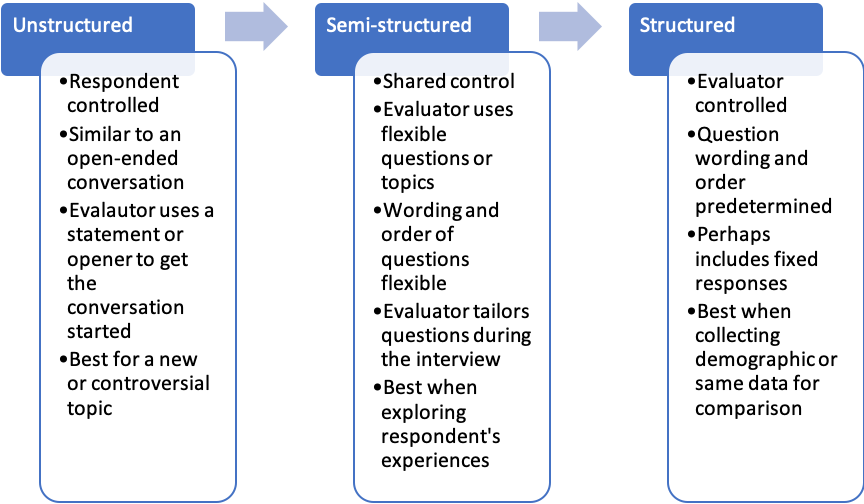Hello again! I am Beverly Peters, an assistant professor of Measurement and Evaluation at American University. This is the second article in a 5 part series on Using Interviews for Monitoring and Evaluation. In the previous article of this series, we learned when evaluators might use interviews to collect data for monitoring and evaluation. This article explores different kinds of interviews, so that we might better understand how we can use interviews most effectively in our work.
The qualitative methods literature tells us that we should categorize our interviews on a continuum that reflects the amount of structure in, and the nature of control over, the interview.
On one side of the interview continuum is an unstructured or open-ended interview, which is essentially a flexible conversation consisting of open-ended statements or questions. In this type of interview, the evaluator lets the respondent control the flow of topics and subjects. I find this type of interview is useful when the topic is controversial, and asking questions about it could be polarizing or even difficult. This kind of interview is also useful when an evaluator is unfamiliar with the topic, and therefore unable to devise meaningful or unbiased questions about it. I also like to use unstructured interviews to gather stories that illustrate data, or to help shed light on quantitative findings.
On the other side of the interview continuum is a structured interview, where the evaluator holds complete control over the interview. In this kind of interview, the evaluator predetermines the wording and the order of the questions. Sometimes the evaluator will also predetermine the responses as well. In this way, a structured interview is similar to a survey. We might use structured interviews to set a baseline of demographic or other data, or to gather data from different respondents for comparison. Structured interviews are a good choice when the evaluator needs to compare data, perhaps from large research populations, over time.
In the middle of the interview continuum is a semi-structured interview, where the evaluator uses a question guide that includes a flexible mix of potential questions and topics to be explored. The guide itself is flexible, and allows for change over the course of the interview. The evaluator uses previous questions and devises new ones based on the conversation with the respondent and the tenor of the interview as it ensues. The evaluator and respondent share control in this type of interview, as the evaluator crafts spontaneous questions to respond to the opinions and experiences of the respondent; and the respondent points out issues that they think are important. To conduct such an interview effectively, you need both the skills to craft spontaneous interview questions, and the knowledge about the topic or project to ensure those questions are appropriate and insightful.

As an evaluator, I am most comfortable in the middle ground of the continuum, using a semi-structured approach. Such an interview allows me to gather the data I need using preconceived questions, and I am able to compare that data between respondents. More importantly, it also gives me the opportunity to go off-topic and craft new questions as I am actually conducting the interview. With these new questions, I can explore areas of expertise or opinions that my respondent expresses during the interview process. This helps me to see new perspectives that I might not have previously considered. I devise solid questions, but I also listen to my respondent and recognize where I should follow up and craft questions spontaneously. This allows me to gather rich, descriptive data that oftentimes provides insight into project activities, outputs, and outcomes.
Do you have questions, concerns, kudos, or content to extend this aea365 contribution? Please add them in the comments section for this post on the aea365 webpage so that we may enrich our community of practice. Would you like to submit an aea365 Tip? Please send a note of interest to aea365@eval.org. aea365 is sponsored by the American Evaluation Association and provides a Tip-a-Day by and for evaluators.

For more on the interview continuum and different kinds of interviews, see these rad resources:
Merriam, S. and Tisdell, E. (2015). “Qualitative Research: A Guide to Design and Implementation,” 4th ed. San Francisco: Wiley.
Murchison, J. (2010). “Ethnography Essentials: Designing, Conducting, and Presenting your Research.” San Francisco: Wiley.
Patton, M.Q. (2015). “Qualitative Research and Evaluation Methods,” 4th ed. Thousand Oaks: SAGE.
Tracy, S. (2019). “Qualitative Research Methods: .”Qualitative Research Methods: Collecting Evidence, Conducting Analysis, Communicating Impact,” 2nd ed. San Francisco: Wiley.